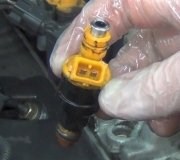Go figure. I just got of the phone two minutes ago with a friend who is broke down and he thinks it's his fuel pump. In fact, he has a GMC Suburban and the sudden failure he described is how Chrysler fuel pumps typically fail. What you described is how GM pumps typically fail.
GM fuel pump almost always start up, then they fail while you're driving, leaving you sitting on the side of the road. It is just about unheard of for a Chrysler fuel pump to stop running once they've started up. They fail by failing to start up, leaving you sitting in the driveway or parking lot. The fact you hear it running for one second when you turn on the ignition switch is all the proof we need to know it is running.
The lack of fuel pressure has me confused. If that only happened after you installed the new pump, the likely suspect is you need to put at least five gallons of gas in the tank. There is usually a bowl inside the tank that the pump's pick-up screen sits in. That keeps the screen covered with gas when the level is low and it runs to the side of the tank when you go around a corner. With my '88 Grand Caravan, as soon as gas is poured in, it drops right into that bowl. With my '94 Grand Voyager, it misses the bowl, then it takes a good five gallons before it spills over into the bowl to fill it. At that point, once the engine is running, the fuel coming back on the return line keeps that bowl full so you can run it down to the last gallon.
The flashing Check Engine light was used up to '95 models to read fault codes. After that, they went to standardized three-digit codes, and Chrysler reads them out directly in the odometer display. At some point they stopped including that feature, but I'm not sure which year. I do know I can't read them without a scanner on my 2014 Ram. If you find that, you may need to borrow a simple code reader to see if there's any stored fault codes.
Cutting out intermittently is much more likely to be caused by the camshaft position or crankshaft position sensor. If there is no fault code referring to them, you will need a scanner to view live data. Under the "Sensors" or the "Inputs / Outputs" drop-down menu, the two sensors will be listed with a "No" for each one when the ignition switch is in the "run" position. Those must switch to "Present" or some similar indication, during cranking, to indicate their signals are showing up. If one stays on "No", check its wiring first, but there's about a 50 percent chance the sensor is causing the problem.
Wednesday, January 8th, 2020 AT 1:26 PM


